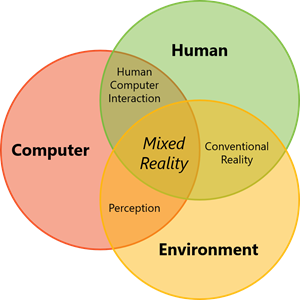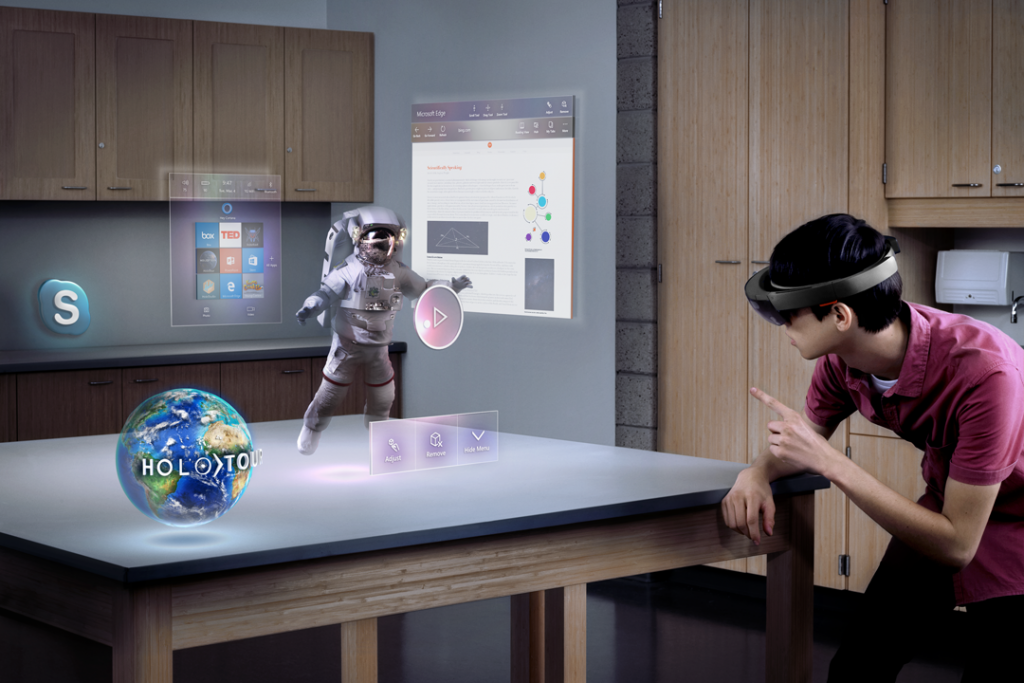Among new technologies, mixed reality is a sort of a dark horse—it has been with us for a while, but people know only partially what it is and what it is not. Mixed reality (MR) is not a synonym for virtual or augmented reality. In fact, if we consider its name, we can understand that this technology mixes two environments, brings them together and creates a unitary, comprehensive experience for the user.
A Short Definition of Mixed Reality
The simplest and most straightforward way of defining mixed reality is this:
Mixed reality is merging of the physical world and the virtual world, creating an environment where real-life items and holographic items coexist, in the same space and at the same time, and can be manipulated by users.
Thus, mixed reality incorporates both virtual reality and augmented reality and creates a new type of immersive experience, in which the users get the best of both these technologies: an accurate mapping of the real world and a seamless integration of virtual objects.
The scheme below is very helpful to understand the concept of mixed reality:

What Devices do you Need to Experience Mixed Reality?
Just like AR and VR, MR can be experienced with a combination of devices. These are:
- The headset: worn over the eyes and ears, the headset has the role of capturing the image of the real life environment through the video camera attached to it, and to overlay the holographic objects through the lenses.
- The computer: definitely a new-generation computer, with a powerful processor (at least Intel Core i5) and separate graphics card. You can check our recommendations in this article.
How does Mixed Reality Work?
To understand the interactions between humans and devices which create mixed reality, take a look at this diagram:

The computer perceives and maps the real-life environment through a camera attached to the headset worn by the user. The processor adds virtual objects created by the MR application and places them in the real-life environment, without obliterating it.
The user can thus perceive both the conventional reality and the virtual one. Through haptics and movement sensors, the computer allows the user to interact with the newly created environment. That is, the user can handle both real-life items (for instance, a chair already present in the room) and the virtual ones (a holographic chair that the user can place next to the real-life chair).
The Evolution of Mixed Reality
Every new technology we enjoy today started from a concept which, at the moment of its postulation, seemed utterly impossible to achieve in reality. For reference, consider the history of virtual reality and the first early attempts of defining it.
The first attempt to define mixed reality was made by two researchers, Paul Milgram and Fumio Kishino, in 1994. In a paper published on the IEICE Transactions on Information and Systems website, they presented mixed reality as “…anywhere between the extrema of the virtuality continuum.” In this case, the term virtuality continuum means an extension from the fully real to the fully virtual environment, with AR and VR acting as in-between mediators.
Although the first theoretical definition dates from 1994, the first practical use of mixed reality happened two years before. In 1992, Louis Rosenberg developed at the Armstrong Labs of US Air Force a training system for pilots named Virtual Fixtures.
The technology made timid steps and even at present you will find fewer MR experiences available, compared to virtual and augmented reality experiences. The reason for this lack of MR content available to consumers is that:
- Mixed reality headsets, such as Microsoft HoloLens, are expensive—$3,000 in the official Microsoft store.

- MR applications are targeted at professional and business uses—such as the Strivr suite of applications for sportspeople and professionals training.
However, the capabilities of mixed reality are quite impressive at present, as you can see in this video:
Present and Future Applications of Mixed Reality
Mixed reality may have a potential for entertainment, but it appears to be more suitable for complex professional use in various industries and business fields. As we mentioned above, a mixed reality suite of applications named Strivr is currently used both by corporations for personnel training and by professional coaches to train sportspeople.
If we look at how virtual reality and augmented reality are already being used in various fields, we can easily incorporate MR in them. For example:
Product design
Engineers and designers can work together on complex products, such as automobiles and airplanes, and make various changes to the body, and add or remove components using a work in progress model and holographic objects. This would allow the specialists to note the impact of any change made to the prototype before the said change is implemented on the real life item, which can be expensive and result in delays.
Mass manufacturing
Plant supervisors and product owners can take a final look at the product model about to be manufactured in large quantities. They can detect potential flaws and stop the production, avoiding financial and material losses.
Logistics and supply chain
Warehouse workers equipped with MR headsets and powerful miniature computers will be able to visually inspect a large batch of product, retrieve expiration dates which are superimposed on real life vision and give voice commands for order picking.
B2B business
Doing business at a top corporate level will become simpler as mixed reality product models or interactive business presentations start eliminating distances and time zones, allowing decision makers to have the next best experience to a face-to-face presentation.
Healthcare
From distance patient-doctor consultations, to surgeries, mixed reality has a huge potential to improve the healthcare field and give doctors powerful tools for accurate diagnoses and for performing delicate surgeries. At the same time, there is a chance that MR models of the human body will replace actual bodies for student training.
There is no telling how far mixed reality will advance in the coming years. But we will be right here to share with you its latest developments.




